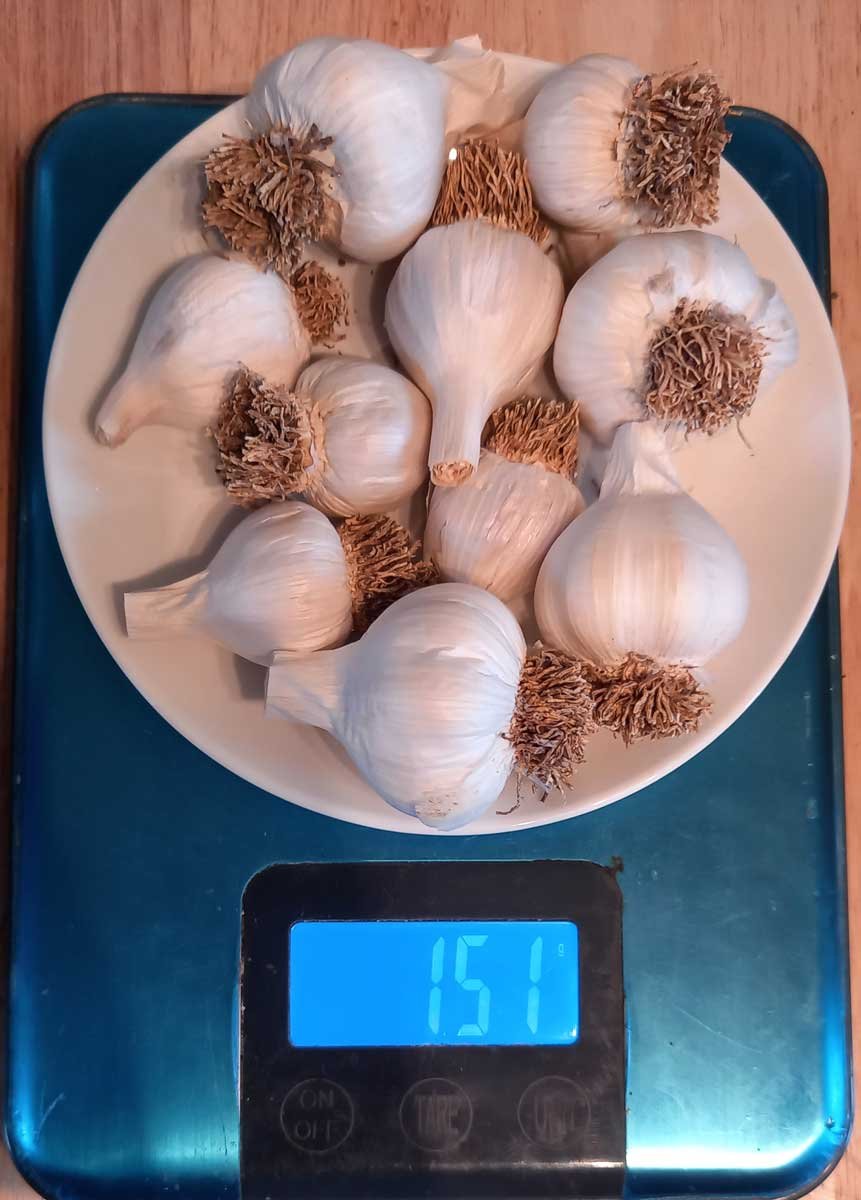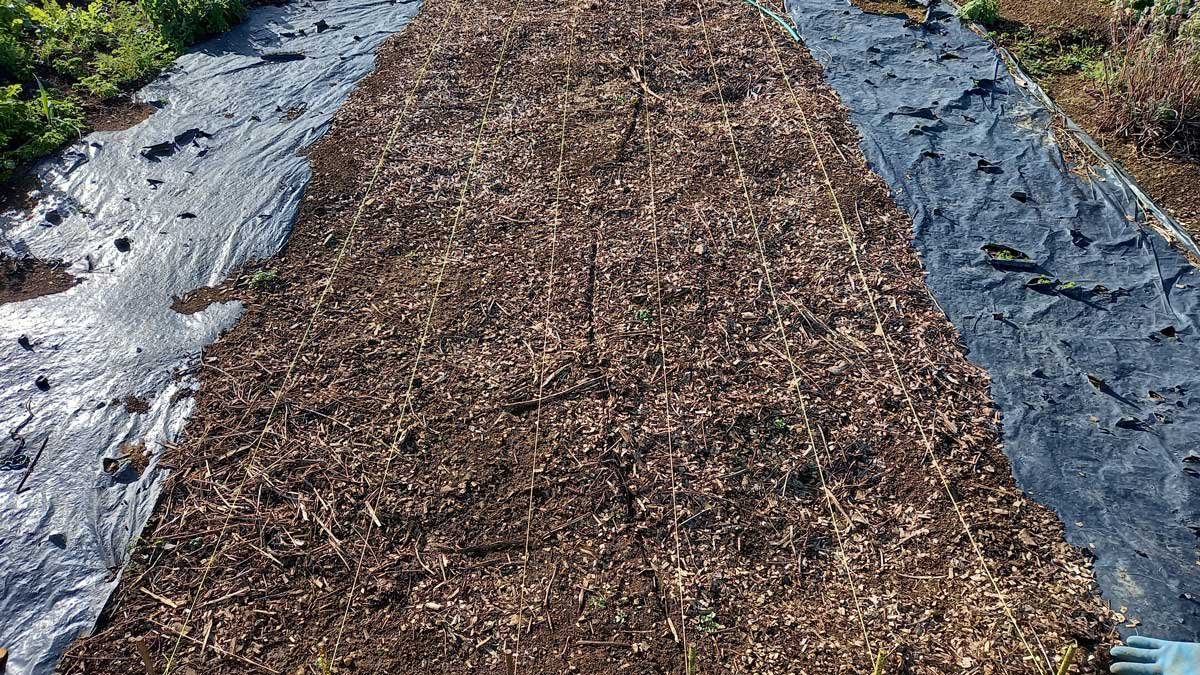Last year’s garlic season was truly shocking. If you’ve followed me for a while, you might know I’m a little bit obsessed with growing garlic, but last year really left me with a horrible taste in my mouth.
I’ve been collecting and growing garlic varieties for years. Since 2017, I’ve been expanding my stock to a point where I hoped I could supply other growers with varieties that aren’t available in garden centers.
In May 2021, I set to work and planted over 1000 garlic cloves by hand. It took days. I was so excited. I hadn’t attempted something so big before.
For months, I tended them. I spent an hour or two weeding them each week. I applied compost. I mulched them. I sang to them while I worked.
Then in about mid-September, I noticed the first signs of rust. I went on the offensive – I ruthlessly removed infected plants; I sprayed with copper; I disinfected tools and gumboots.
But by the beginning of November, the beautiful garlic I’d tended so lovingly was just… yellow.

29 September 2021

11 November 2021
Harvest 2021
I monitored the growth of the garlic by pulling out a plant and peeling it back every couple of weeks. They grew at different rates, but I started pulling them when I no longer had any choice about it.

They were coming up in late November/early December and they were tiny.
Honestly, so small. Maybe 25% of the size we usually pull up. And heaps were rotting.
There was no way I could sell this to growers as seed garlic. That meant a massive loss for me.
This is probably when a commercial farmer might cut their losses. They’d understand the sunk-cost was enough of a loss and the cost of processing to get to a saleable product wouldn’t be worth the investment.
Nevertheless, I pulled up my thousand garlics. Then I sorted, processed, and dried what I could. Processing garlic involves peeling it clean and bundling it to dry. Then after it’s dry you take off the leaves and clip back the roots. It took about a week all up.

I was standing over bins destined for the green waste in the blazing heat; inspecting, sorting, bundling, and trimming. All while feeling like a giant fucking failure. So much of it simply went in the bin.
I rescued as many of the rotting bulbs as I could. I took the cloves that were unaffected and peeled hundreds by hand. I turned them into rosemary and garlic salt which became a (quite popular!) Christmas gift for friends and family. The cabin stank of garlic for a week, but the delighted feedback has been one of the best things about last year’s harvest.
I sold what I could as eating garlic in January. All up, after months of hard work and dedication, I made about $150 from my 2021 crop.
Over it
If I could have taken this year off, I would have. That rust really broke me. It wasn’t just a failure, it was a really big failure that I just had to keep working through.
I’ve collected these varieties over years. I spent months hunched over those garden beds working. So many hours of work and care and attention – and in the end I got paid for less than 8 hours of that work at the minimum wage.
But I did manage to grow just enough acceptable bulbs to carry on five varieties. And I’m not so over it that I didn’t pick up a new variety when I got an email from Setha’s Seeds earlier this year. The work I’d put in over the years before 2021 meant I owed it to myself to pick myself back up and try again, at least once.
So I decided that in 2022, I’m just focusing on keeping the varieties going. That’s it. I’m not expanding out into a massive seed crop, I’m not planting thousands of garlics. I’m just maintaining the work I’ve spent the last 5 years slowly developing.
Reflection
Everyone has an opinion on when to plant. They say it depends on the variety, or where you are in the world. Most recommend planting early. Literally no advice on when to plant what variety has ever actually been helpful to me.
We live in a part of New Zealand that is warm and very, very wet in winter. Frosts are rare and comparatively light. I’ve concluded that planting early just means my garlic is exposed to more rain, making it more susceptible to fungal diseases like rust.
So I decided I wouldn’t plant early. This was good because it allowed me to procrastinate a job I was truly dreading for as long as possible.
With a little reflection I realised one of my best years here (the first) was planted on 1 August. I’ve also done well with Solstice plantings here – the garlic that was planted on Solstice last year was some of my best stuff when it was lifted.
Setting my trusty moon calendar at the beginning of June, I noticed that Solstice and the day for planting root vegetables lined up.
After last year, I need every advantage I can get: past experience, conventional wisdom, and magic gardening tools that I don’t understand but at least offer the placebo of working – I’ll take them all.
The date was set: 22 June. I chose my best garden bed and weeded it. Then I tried to forget about it.
Planting day
Physically, I was wrecked from last weekend’s mulch-a-palooza. My right hip had something twigging and my right knee had started up with a new click out of nowhere which was also cool. I really wanted a nap.
But the appointed day was sunny, barely a breeze. My Twitter feed was making me angry. Everything said “plant your garlics today you grumpy old lady!” And so I attacked this task with absolutely no enthusiasm.
I cracked open the ‘keepers’ and selected the cloves for planting – about 20-30 of each variety, but I wasn’t keeping count. I soaked the cloves in a solution made of 1 litre of water, 1/4c of apple cider vinegar, and 1/4c organic liquid fertiliser.
Last year the soaking in fertiliser seemed to help. I saw some good results in the soaked ones, despite the rust. I’m hoping the ACV will do something to disinfect them and set them up for success, but that’s a bit of a wing-and-a-prayer. There’s no evidence to say it’ll do anything at all.

Then I went out and set up a string line, and roped Richard into helping me dig holes. We planted about 140 cloves of garlic over 90 minutes in the afternoon sun.
Our lines will probably be wonky, but the garlic was planted and I no longer care.
Care and attention
I’d like to dump some compost on top of the bed, but we’ll see. This bed has already been mulched with wood chips that were made just before Christmas. I’m a bit wary of putting anything on top in case it leads to nitrogen issues.
What I will be doing from the moment these babies pop their head up will be to spray them with an apple cider vinegar solution weekly. It’s a tip from a lady on the Facebook group ‘Garlic gurus N.Z.‘ and she really sold it in her post.
I’m at the end of my rope, so I’m going to focus on that. She recommended 1c of vinegar in a 5l sprayer of water, and said the cheap stuff will do the trick. I like this idea as a preventative a lot more than hitting it with copper every week. I’ll probably add some seaweed fertiliser as a foliar spray too.
The garden bed they’re in has a very low weed load, so I shouldn’t have to weed so much this year. Just spray vinegar and seaweed once a week. Keep it simple. Low bar, low stress.
The goal is to grow healthy garlic. Just to keep my little collection alive. I’m making no promises and have no expectations. What will be, will be.
May they grow strong and healthy – because if they fail again, I think I’m done.



I bought garlic from you earlier this year and have loved it. I finished it this weekend and look forward to buying again from you. All the best; I really admire your tenacity and spirit.
Thanks Robbie! I’m so glad to hear you enjoyed it. Fingers crossed this year’s effort will end in a small success that will buoy me through to next year, but I’m trying not to hold onto the outcome too much!
Hi Kat
Good luck with your garlic this year. Is garlic like spuds and not like being planted in the same bed 2 years running?
I seem to remember hearing or reading that somewhere.
Is there a way to make sure the rust virus is dead and gone from your soil.
Fingers crossed all plain sailing from here on.